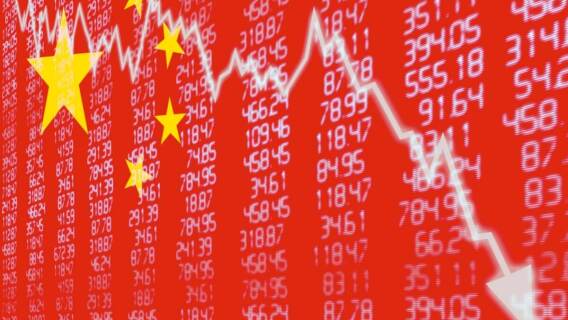On January 13, China’s benchmark Shanghai Composite Index closed at 3,115, an eight-month high. This was two days after the country reported its first death from the novel COVID-19 coronavirus. Three weeks later, on February 3, there were 425 deaths in the world’s most populous country, and more than 20,000 people had fallen sick from the highly infectious disease. Meanwhile, Chinese stocks were bottoming … or so it seemed.
Of course, things got much worse in China in the ensuing weeks, as the number of cases quadrupled, topping 80,000 on the first day of March. As the death toll rose and the number of infected multiplied, however, Chinese stocks staged a February rally, recovering most of their January losses. By March 5, the Shanghai Composite Index closed at 3,071—a mere 1.4% off its pre-virus high less than two months earlier.
[text_ad]
With cases in China having mercifully slowed to a crawl—the country has reported just 1,300 new cases in March—Chinese stocks were bound to rally to newer heights. Right? Wrong.
Here’s what has happened to the Shanghai Composite Index this month:
It’s fallen—even further than it fell before. A new bottom appears to have been put in exactly a week ago, on March 23. That bottom was 3.1% lower than the early-February one. Chinese stocks have since rebounded, but they’re still way off their early-March highs.
The action in the Shanghai Composite is a reminder that stock markets are forward-looking; Chinese stocks fell sharpest before the spread of coronavirus in Hubei Province got way worse. And while the virus has appeared relatively under control for the last month, stocks have fallen again—likely in anticipation of what the total economic damage to the country will be.
Might U.S. Stocks Mimic Chinese Stocks?
That brings me to U.S. stocks. Here’s what a three-month chart of the S&P 500 looks like:
Yikes. As you can see, U.S. stocks fell even further than Chinese stocks, with the S&P 500 nose-diving 34% in little more than a month. Interestingly, the index bottomed on March 23—the same day that the Shanghai Composite Index was putting in its second virus-related bottom. And like Chinese stocks in early February, the V-shaped rally in U.S. stocks since has come against the backdrop of the spread of COVID-19 getting exponentially worse, as America is now the most infected nation in the world, with more than 150,000 cases as of this writing.
So, with the U.S. running about five to six weeks behind China, should we expect U.S. stocks to follow a similar double bottom chart pattern to the Shanghai Composite Index? If so, that would mean another three weeks or so of recovery, followed by an even steeper dip to lower lows, perhaps sometime in the first half of May, as investors truly grasp the economic damage that’s been done.
It’s possible. But comparing the pattern in Chinese stocks to the behavior and anticipated behavior in U.S. stocks is a bit apples-to-oranges. For one, Chinese stocks, unlike U.S. stocks, didn’t enter their coronavirus market pullback at all-time highs. In fact, they were trading at about 40% below their five-year highs, established in June 2015, and even further below their pre-global recession peaks from late 2007.
Thus, the peak-to-trough dip in Chinese stocks has been far more palatable—less than 15%. Chinese stocks have been under pressure for years, so there simply aren’t many sellers left—which bodes well if you’re an emerging markets investor (you should be).
Also, China quelled the coronavirus surge quicker than America has. Until the U.S. “flattens the curve” – meaning the number of new daily cases declines, as does the death rate – then the market will remain extremely volatile. Wall Street doesn’t do well with unknowns, and right now no one knows for sure when America’s coronavirus outbreak will start to recede.
3 Real Takeaways from the Shanghai Composite Index
Given those differences, however, the action in Chinese stocks at least provides us with a broad template of what to expect. Here are a few takeaways from the action in the Shanghai Composite that might hold up:
1. This won’t be a pure V-shaped rally. Eventually, stocks will re-test, and perhaps dip below, their previous lows. Don’t fall for this false start and start gobbling up stocks willy-nilly.
2. Because the market is forward looking, worsening news about the virus in real time may not affect stocks’ behavior. In other words, the bad news has already been factored in. So pay attention to the charts, not the news—if you can.
3. This bottoming process will take months, not weeks. China’s coronavirus outbreak began in late December/early January. Chinese stocks didn’t fully bottom (if they have bottomed) until March 23. Thus, while the outbreak itself may be under much better control a month from now, U.S. stock prices may well be lower than they are today.
Again, this is all speculation. I’m not going to make any bold stock market predictions. It’s best to stick with the evidence in the charts, limit buying until a true bottom is established (likely months from now), and prune your weakest stocks from your portfolio.
And above all, keep reading Cabot Wealth! We’re here for you through these troubled times. To read all our latest investing advice, stay tuned to the Cabotwealth.com website. It’s free.
If you want deeper, more stock-specific advice catered to your particular investing preferences, click here to learn how to subscribe to any of our 13 investment advisories.
In the meantime, stay safe—and stay healthy.
[author_ad]



